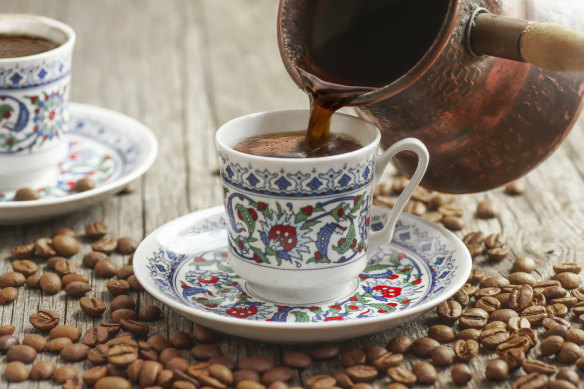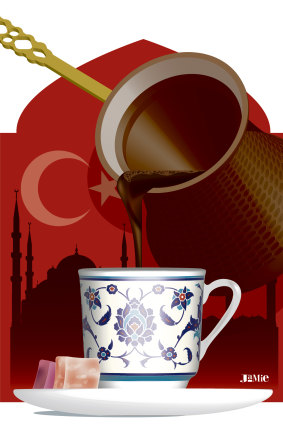This was published 1 year ago
How to drink coffee, Turkish-style (don’t ask for milk)
Traditional Turkish coffee is black as hell, strong as death and sweet as love, according to an old proverb. In a traditional coffeehouse, you can usually watch as it’s made in a heavy-bottomed coffeepot with a long handle, over a blazing gas flame or charcoal fire.
It arrives at your table in a small cup or glass, topped with a layer of froth and full of the super-fine grounds that give it its strength. Let the coffee settle for a minute or two before you drink it. You can still expect it to be slightly gritty.

Turkish cofeeCredit: iStock
If you want sugar, ask for it when you order, since it’s added during the brewing process. Sometimes spices such as chicory or coriander, but especially cardamom, are added too. Don’t think about asking for milk; there’s no room in the cup for it anyway.
A few sips and you’re done. Don’t drink the dregs. Mark Twain memorably warns in The Innocents Abroad (1869) that the sludge going down your throat leaves you with “a tickling aggravation that keeps you barking and coughing for an hour”.
Once done, you can ask the fortune tellers that wander coffeehouses to read the grounds on the side of your cup after it has been turned over on a saucer. As few of them speak English, you’ll need a translator.

Credit: Illustration: Jamie Brown
Turkish coffee comes with a glass of water to refresh your palate before you drink, and to rinse out stray grounds afterwards. You’ll find a small square of lokum (Turkish delight) or baklava on your saucer. Eat that first: the lingering sweetness in your mouth counteracts the very strong and slightly bitter coffee.
It’s hard to resist ordering a larger portion of lokum studded with pistachios or candied fruit, or one of Turkey’s tempting pastries flavoured with honey syrup and nuts, which come with wonderful names such as lady’s lips or nightingale’s nest. Elegance and imagination is saved for the sweet treats, not for coffeehouse decor.
Traditional coffeehouses are rough-and-ready, with a minimalist arrangement of wooden tables, spotted mirrors, and posters of Turkish pop starlets and first Turkish president Ataturk pinned to the walls. Coffeehouses often still separated by gender, especially outside big cities.
Turkish coffee isn’t consumed for breakfast (tea is more common) but rather after a meal or as a mid-afternoon pick-me-up. As locals drink, they read newspapers or play backgammon and in the evenings they smoke shishas, their gurgles sinking everyone into postprandial contentment.
Trendy international cafes have appeared in Turkish cities and holiday resorts, where you can get lattes or espressos, but why would you? Turkish coffee isn’t just a drink but a symbol of hospitality served whenever you’re invited into a local home. It’s a living symbol of Turkish society now enshrined as a UNESCO Intangible Cultural Heritage.
Sit in coffeehouses amid the clink of saucers and clack of backgammon pieces. Inhale the aromas. Enfold yourself in the chatter and ambience. Leave aside the mosques and museums for an hour, and enjoy the moment.
Sign up for the Traveller Deals newsletter
Get exclusive travel deals delivered straight to your inbox. Sign up now.